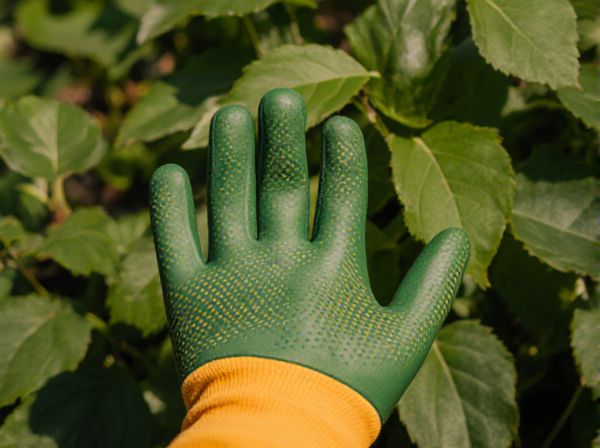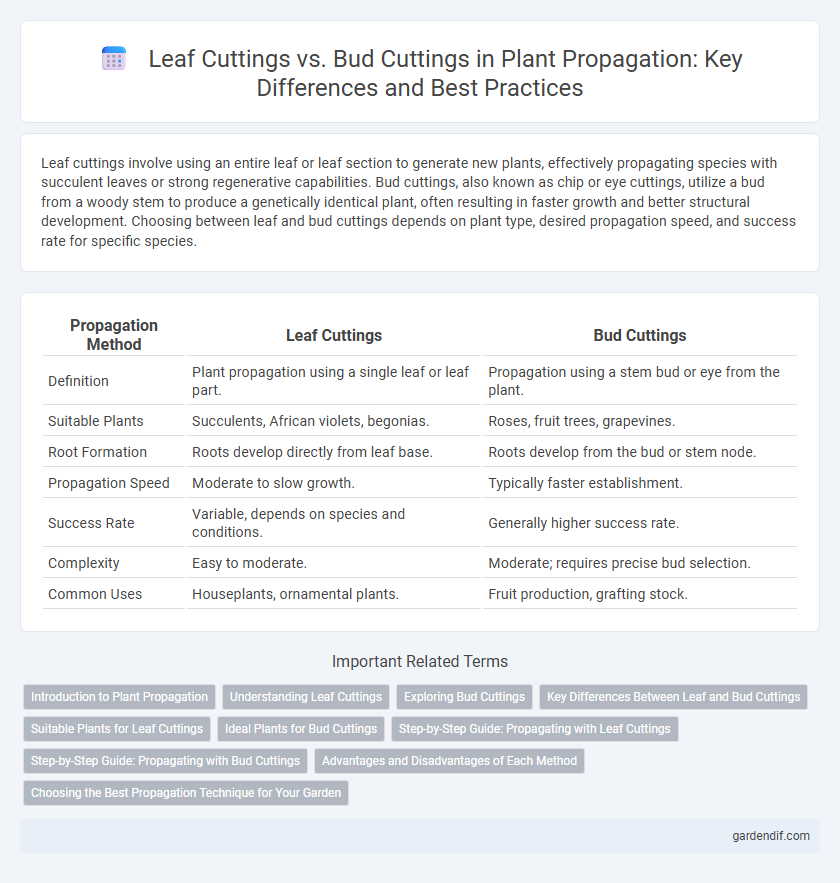
Leaf cuttings vs bud cuttings Illustration
Leaf cuttings involve using an entire leaf or leaf section to generate new plants, effectively propagating species with succulent leaves or strong regenerative capabilities. Bud cuttings, also known as chip or eye cuttings, utilize a bud from a woody stem to produce a genetically identical plant, often resulting in faster growth and better structural development. Choosing between leaf and bud cuttings depends on plant type, desired propagation speed, and success rate for specific species.
Table of Comparison
| Propagation Method | Leaf Cuttings | Bud Cuttings |
|---|---|---|
| Definition | Plant propagation using a single leaf or leaf part. | Propagation using a stem bud or eye from the plant. |
| Suitable Plants | Succulents, African violets, begonias. | Roses, fruit trees, grapevines. |
| Root Formation | Roots develop directly from leaf base. | Roots develop from the bud or stem node. |
| Propagation Speed | Moderate to slow growth. | Typically faster establishment. |
| Success Rate | Variable, depends on species and conditions. | Generally higher success rate. |
| Complexity | Easy to moderate. | Moderate; requires precise bud selection. |
| Common Uses | Houseplants, ornamental plants. | Fruit production, grafting stock. |
Introduction to Plant Propagation
Leaf cuttings and bud cuttings are essential methods in plant propagation used to reproduce new plants from specific plant parts. Leaf cuttings utilize a whole or part of a leaf to generate roots and shoots, proving effective for plants like African violets and begonias. Bud cuttings involve removing a bud from the parent plant, often used with woody species, ensuring genetic consistency while minimizing parent plant damage.
Understanding Leaf Cuttings
Leaf cuttings involve using a single leaf or a portion of a leaf to propagate new plants by encouraging root and shoot development from the leaf tissue, commonly practiced in succulents and certain houseplants such as African violets. This method relies on the leaf's ability to generate adventitious roots and buds, enabling the formation of an entirely new plant genetically identical to the parent. Leaf cuttings are advantageous for producing multiple plants rapidly but require specific environmental conditions like high humidity and indirect light to ensure successful rooting and growth.
Exploring Bud Cuttings
Bud cuttings offer a higher success rate in propagation by utilizing dormant buds to produce genetically identical plants, ensuring uniformity and vigor. This method requires less tissue and results in faster establishment compared to leaf cuttings, which often demand more extensive care and longer rooting times. Bud cuttings are especially effective for woody plants and fruit trees, where maintaining cultivar traits is critical for commercial propagation.
Key Differences Between Leaf and Bud Cuttings
Leaf cuttings involve using an entire leaf or a section of a leaf to generate a new plant, primarily suitable for species like begonias and succulents. Bud cuttings, also called eye cuttings, use a section of stem with a single bud, common in propagating woody plants such as roses and grapes. The main differences lie in the origin of new growth--leaves for leaf cuttings and axillary buds for bud cuttings--and the types of plants best suited for each method.
Suitable Plants for Leaf Cuttings
Leaf cuttings are particularly suitable for plants like African violets, begonias, and succulents, which have fleshy leaves capable of generating roots and shoots independently. These plants naturally possess meristematic cells within their leaves that facilitate efficient vegetative propagation. Compared to bud cuttings, leaf cuttings enable propagation without requiring woody stems or nodes, making them ideal for herbaceous and soft-stemmed species.
Ideal Plants for Bud Cuttings
Ideal plants for bud cuttings include fruit trees like figs, grapes, and apples, as well as certain shrubs such as roses and camellias, which root more successfully through this method. Bud cuttings preserve the genetic material of the plant more reliably by using a single bud inserted into a rootstock, promoting quicker establishment and growth. This method is particularly effective for woody plants that may struggle with rooting from leaf cuttings.
Step-by-Step Guide: Propagating with Leaf Cuttings
Leaf cuttings require selecting a healthy leaf, cutting it cleanly at the base, and placing it in a well-draining propagation medium such as a mix of peat and perlite to encourage root development. Maintaining a warm, humid environment with indirect light helps prevent desiccation while promoting callus formation and subsequent root growth. Regular monitoring for new shoots and roots within 2-4 weeks ensures successful propagation before transplanting the new plantlets.
Step-by-Step Guide: Propagating with Bud Cuttings
To propagate using bud cuttings, select a healthy stem and carefully cut a single dormant bud along with a small portion of the stem, ensuring the bud's base remains intact. Insert the prepared bud into a prepared rootstock by making a precise T-shaped cut and securing it with grafting tape or clips to encourage successful union. Maintain optimal humidity and temperature conditions, monitoring for bud swelling and shoot growth, which indicate successful propagation within two to four weeks.
Advantages and Disadvantages of Each Method
Leaf cuttings offer a simple and cost-effective propagation method particularly suited for plants with fleshy leaves, allowing rapid multiplication without requiring mature stems; however, they often have lower success rates and slower growth compared to bud cuttings. Bud cuttings enable propagation from mature plant material with higher rooting success and faster development due to stored nutrients in the dormant buds but may require more skill, careful handling, and sterile conditions. Choosing between leaf and bud cuttings depends on species-specific responses, propagation goals, and available resources, as each method balances ease, efficiency, and reliability differently.
Choosing the Best Propagation Technique for Your Garden
Leaf cuttings are ideal for propagating plants like succulents and begonias, enabling rapid production of clones from a single leaf. Bud cuttings work best for woody shrubs and fruit trees, offering higher success rates by preserving a dormant bud capable of generating new shoots. Selecting the right technique depends on plant species, propagation speed, and desired growth outcomes in your garden.
Leaf cuttings vs bud cuttings Infographic

 gardendif.com
gardendif.com